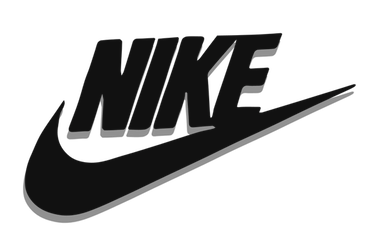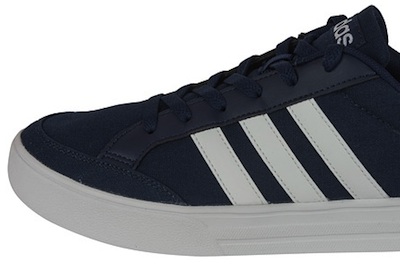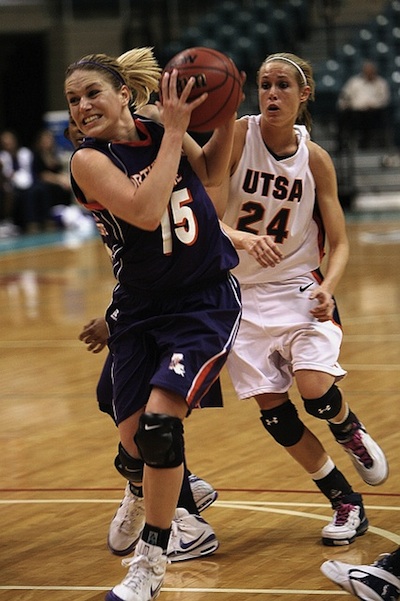

Do Athletic Shoe Contracts Benefit Male and Female Athletes Equally?
If you follow news in the world of sports, or any news at all, you’ve probably heard about the lucrative contracts that big shoe companies like Nike, Adidas, and Under Armour have with college sports teams. The companies provide shoes, apparel, and even cash in exchange for athletes wearing their brands and universities selling merchandise with their logos.

It’s not too difficult to find specific details about these contracts online, including their values and the benefits for both sides. But most of the stories out there are about the men’s teams and how much free merchandise the male athletes get through these contracts.
Since this is a website that focuses on women’s athletic shoes, I wanted to present a different perspective by looking into how these shoe contracts affect female athletes. Do they get the same benefits as the men?
How Athletic Shoe Contracts Work
Nike was the first company to start college apparel contracts, but Adidas and Under Armour are starting to catch up. The deals usually run for 10 to 15 years and amount to millions of dollars. Most contracts consist of an annual cash payment as well as clothes, shoes, and equipment. Some even include bonus payouts if teams make it to post-season tournaments or win championships.

You can find a database of athletic shoe contracts here. Just search for the school you’re interested in, and you can find out which company they have a contract with and how much it’s worth. You can even view copies of the actual contracts.
According to Jonathan Jensen from the University of North Carolina Center for Research in Intercollegiate Athletics, contract values are based on factors like "student enrollment, the number of times a basketball team has appeared in the NCAA tournament, the size of a football stadium, and attendance at sporting events." And the shoe companies prefer to partner with universities that have success in both football and basketball, leading to optimum exposure. (source)
Do Shoe Contracts Benefit Student-Athletes Too?
So what exactly are the benefits of these contracts? It’s obvious that the shoe companies are getting a great deal of advertising exposure. The student-athletes are wearing their logos all over national television, in regular season games and in the NCAA tournament that is watched by millions of people. Fans are buying jerseys and other school clothing and accessories that feature these logos, furthering their exposure all over the world.
Many athletic shoe contracts give tickets to the schools’ biggest sporting events to company officials, and even provide for prime parking at the event venues. The shoe companies sponsor their own tournaments, and some contracts specify that smaller teams, like softball or tennis teams, have to play in these tournaments every few years. So they have guarantees that teams will participate and bring in more fans and more money.
It’s pretty easy to see how the shoe companies benefit from these contracts. But what about the athletes? Of course they receive free shoes, apparel, and equipment. According to a New York Times story, basketball players get so much free merchandise that they give a lot of it away to friends and family. But the players are amateur athletes, so the one thing they cannot do with their free merchandise is sell it.
I also noticed in some of the contracts that a small number of students at the partner universities have an opportunity to work as interns in the shoe company’s offices.
Fair Distribution?
So we’ve established that contracts between shoe companies and universities provide a lot of free merchandise to the student-athletes. But how is that merchandise distributed? Do male athletes get more than female athletes, or is it distributed equally?
I reached out to several university athletic departments to ask these questions, and to a few student-athletes directly, but I have not received any replies from any of them.
Matthew Kish is a reporter from the Portland Business Journal who investigated shoe contracts and helped compile the database of contracts I referred to above. He told me that in general, the athletic shoe contracts contracts guarantee an annual cash payment and an annual equipment and apparel allocation. But it is the universities that decide how to split up both. Some contracts include specific language about how much goes to specific teams, but most do not.
Jonathan Jensen, a researcher with the University of North Carolina’s Center for Research in Intercollegiate Athletics, told me the following:
“Typically, the apparel agreements with the universities do not specify how much of the cash and/or apparel being provided is distributed to men's or women's teams. That is up to the individual institutions. Based on Title IX, men's basketball teams should receive the same amount of apparel and shoes as the women's teams.
“However, the one area that does allow for a
means of comparison is the bonus structures in the agreements. They typically provide bonuses for
performance in football, men's, and women's basketball, and sometimes sports
such as baseball and soccer.
“Using the database, you could compare the bonuses for conference titles or championships for men's and women's basketball, for example, and that could show some evidence of some inequities. That’s probably the only area of these agreements that you can use to compare apples to apples.”
What Do the Contracts Show?
Since women do not have football teams, it makes the most sense to compare college basketball teams. The most successful women’s basketball team in the country is the University of Connecticut Huskies. The team has won a record 11 NCAA Division I National Championships and more than 40 conference and tournament championships.
The Connecticut men’s basketball team has won 4 National Championships and 18 conference and tournament championships.

UConn’s contract for all men’s and women’s sports is with Nike, and it’s worth $32.4 million through the year 2023. Interestingly, according to an article in the Hartford Courant about the contract:
“Should UConn win big in certain sports, it will be rewarded by Nike. Men's basketball would receive $25,000 for reaching the Final Four and $25,000 more (bonuses being cumulative) for winning a national championship. Women's basketball payouts are $10,000 for the Final Four and $15,000 for a national championship. Football team incentives include $10,000 for playing in a conference championship game, $20,000 for winning a conference championship game, $25,000 for reaching a playoff game, $50,000 for reaching a national championship game, and $100,000 for winning the whole thing.”
Does this mean that Nike or the university consider men’s sports to be worth more than women’s? Or is Nike actually realizing the chances of paying bonuses for women’s basketball are much higher than for men’s basketball or for football, and they are just trying to save themselves some money?
UConn officials have not responded to my inquiries about their athletic shoe contract.
More Contracts
According to a ESPN’s Darren Rovell, the top six largest college shoe and apparel deals are:
UCLA & Under Armour: 15 years, $280 million
Ohio State & Nike: 15 years, $252 million
Texas & Nike: 15 years, $250 million
Kansas & Adidas: 14 years, $191 million
Michigan & Nike: 15 years, $173.8 million
Louisville & Adidas: 10 years, $160 million
So I checked the contract database for a few of these schools.
Since we already talked about a Nike contract with UConn, here’s the bonus structure in UCLA’s contract with Under Armour comparing men’s basketball with women’s basketball. It shows the bonus amount that each team would earn based on the specific achievements:
Men |
Women | |
|
Regular Season Conference Champions |
$35,000 (incremental) |
None |
|
Wins Post-Season Conference Tournament |
$75,000 (incremental) |
$40,000 (incremental) |
|
Plays in NCAA Tournament First Round Game |
$15,000 |
$5,000 |
|
Plays in NCAA Tournament Second Round Game |
$25,000 |
None |
|
Plays in NCAA Tournament Sweet 16 Game |
$50,000 |
$10,000 |
|
Plays in NCAA Tournament Elite 8 Game |
$75,000 |
None |
|
Plays in NCAA Tournament Final 4 Game |
$100,000 |
$35,000 |
|
Plays in NCAA Tournament Championship Game |
$150,0000 |
$75,000 |
|
Team Wins NCAA National Championship |
$200,000 |
$100,000 |
And here are some details about Louisville’s contract with Adidas, again comparing bonuses for performance in men’s basketball and women’s basketball:
Men |
Women | |
|
Wins Post-Season Conference Tournament |
$50,000 |
$25,000 |
|
Plays in NCAA Tournament Final 4 Game |
$150,000 |
$75,000 |
|
Team Wins NCAA National Championship |
$300,000 |
$200,000 |
So in three different contracts between three different universities and three different shoe companies, the women’s basketball teams are set up to make significantly less in bonus incentives than the men’s teams.
As I mentioned above, none of the officials I reached out to at the universities responded to my inquiries about their contracts.
Feel free to use the database to check the athletic shoe contracts for your favorite colleges to see how their men’s and women’s teams compare. Please send me your comments through the form at the bottom of this page if you find anything that you’d like to share!
What Does it All Mean?
Although the different bonus structures for men’s and women’s basketball may be unfair, it does not seem to violate Title IX.
Title IX of the Education Amendments Act of 1972 is a federal law that states:
"No person in the United States shall, on the basis of sex, be excluded from participation in, be denied the benefits of, or be subjected to discrimination under any education program or activity receiving Federal financial assistance."
According to the NCAA, Title IX does not require that equal money be spent on men’s and women’s sports. “The only provision that requires that the same dollars be spent proportional to participation is scholarships. Otherwise, male and female student-athletes must receive equitable ‘treatment’ and ‘benefits.’”
It does sound like male and female athletes should receive the same amount of free merchandise through these athletic shoe contracts in order to follow NCAA and Title IX regulations, as that would seem to fall under “benefits.”
But it’s up to the universities to decide how they want to distribute bonus money from shoe contracts, and it’s not against NCAA regulations or federal laws to distribute them unevenly. They apparently have their reasons for giving more to the men’s teams than to the women’s teams, and if I ever hear back from any of the schools I reached out to, I will update this article with their explanations.
I welcome any comments from athletes or university administrators who are willing to share their personal experiences and knowledge about athletic shoe contracts. Please submit your comments through the form at the bottom of this page, and I would be happy to share your information with readers.
